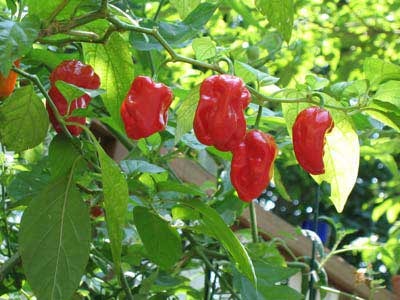Techniques for growing sweet peppers (Capsicum annum L.) in a safe direction
Sweet pepper (Capsicum annum L.) is a thermophilic plant, the suitable temperature for growth and development of pepper is 25 - 28 degrees Celsius during the day and 18 - 22 degrees Celsius at night. Pepper plants need a lot of light, if there is a lack of light, especially during the flowering period, it will reduce the fruit set rate.
 |
Chili peppers can withstand drought, however, during flowering and fruit setting, humidity (soil and air) plays an important role in the formation of fruit mass and quality. Low soil humidity (below 70%) often causes the fruit to be curved and the skin to be rough. However, chili peppers cannot tolerate waterlogging. Too high soil humidity (over 80%) causes poor root development and stunted plants.
1. Seasonal
Winter-Spring crop: Sow seeds October - December, plant January - February, harvest April - May to June - July.
Summer-Fall crop: Sow seeds in June and July; plant in August and September, harvest in January and February.
2. Nursery
Use seeds with high yield, quality and resistance to pests and diseases. Before sowing, treat seeds with potassium permanganate or boiling water at 50 degrees Celsius. Prepare the soil thoroughly, add 3 - 4 kg of decomposed manure/m2, sow seeds at 0.5 - 0.6 g/m2. After sowing, cover the bed with a layer of chopped straw. Seedlings with 1 - 2 true leaves, prune out bad plants to a density of 3 x 4 cm. Seedlings with 5 - 6 true leaves can be planted (about 25 - 30 days after sowing).
Chili pepper seedling standards: Hard, thick stem, short distance between leaves, free of pests and diseases.
3. Tilling, fertilizing, planting
Chili should be grown on alluvial soil with an organic content greater than or equal to 1.5%, pH 5.5 - 7.0, best 6.5 - 6.8. The place to grow clean chili must be far from wastewater sources, far from industrial zones, at least 100m from national highways. The land must ensure proactive irrigation.
Expose the soil to the ground, prepare the soil thoroughly, make beds 1m wide, 30cm high, and 20cm wide furrows. Plant two rows 0.6 x 0.4m apart.
4. Fertilization
Fertilizers only use composted manure and inorganic fertilizers, absolutely do not use fresh manure. The amount of fertilizer for one hectare is: 25 tons of composted manure (900 - 950 kg/Northern pole), 150 N, 90 P2O5, 150 K2O (11 kg of urea, 21 kg of superphosphate, 11 kg of potassium sulfate/Northern pole).
- Base fertilizer: All manure + phosphate + 20% nitrogen + 30% potassium.
- Top dressing:
+ 1st time when the anise plant is green: 10% nitrogen.
+ 2nd time when the tree buds: 20% nitrogen + 20% potassium.
+ 3rd time when the tree bears fruit: 30% nitrogen + 30% potassium.
+ 4th time after first harvest: apply the remaining fertilizer.
Ammonium nitrate, ammonium sulfate can be used instead of urea, potassium chloride instead of potassium sulfate or mixed fertilizers, NPK complexes with equivalent pure dosage, or nutrient solutions can be sprayed on leaves according to the manufacturer's instructions.
5. Watering and care
Absolutely do not use wastewater or stagnant pond water for irrigation. It is best to use well water or unpolluted river water. Before fertilizing, weed, hoe, mound, and water the base of the soil, and water. During the budding, flowering, fruiting, and fruiting stages, ensure adequate watering. If possible, water the furrows. After the surface of the furrows has been soaked with water, all stagnant water in the furrows must be drained.
6. Pest control
- Anthracnose (Collettotricum nigrum El. et stal.): This is a dangerous disease that causes massive fruit rot. Because the disease appears at the stage when the fruit is ripe, at high temperatures (30 degrees Celsius) and with heavy rain, it is very difficult to prevent with chemicals. Because the fungus exists on crop residues, strict crop rotation must be implemented. Do not continuously plant chili on the same field or plant chili after nightshade plants. Use Zineb 0.3%, Bordeaux or Copper Oxychloride 0.7%.
- Downy mildew (Phytophthora infestant) damages all parts of the chili plant. The disease starts from the leaf edge, then spreads quickly to the whole plant, causing soft rot, then drying and breaking. Flowers turn brown and fall off. Spray to prevent with Zineb 0.3%, Copper Oxychloride 0.7%.
- Wilt disease (Fusarium oxysporum F. lycopensici) appears mainly from seedling stage to flowering. Use a mixture of Kasuzan 0.2%, Fudazol 0.15 to control.
- White spider (Poliphago tarsonemus Latus) causes curled tips and leaves. Use Applaut 0.2%, Ortus, Kinalux to kill.
- Aphids (Aphis sp). usually appear in late April and early May. Use Actara to control them.
7. Harvest
Harvest chili when the fruit is ripe, avoid crushing the fruit, remove rotten fruit or fruit with pests.
According to Khuyennongquocgia






